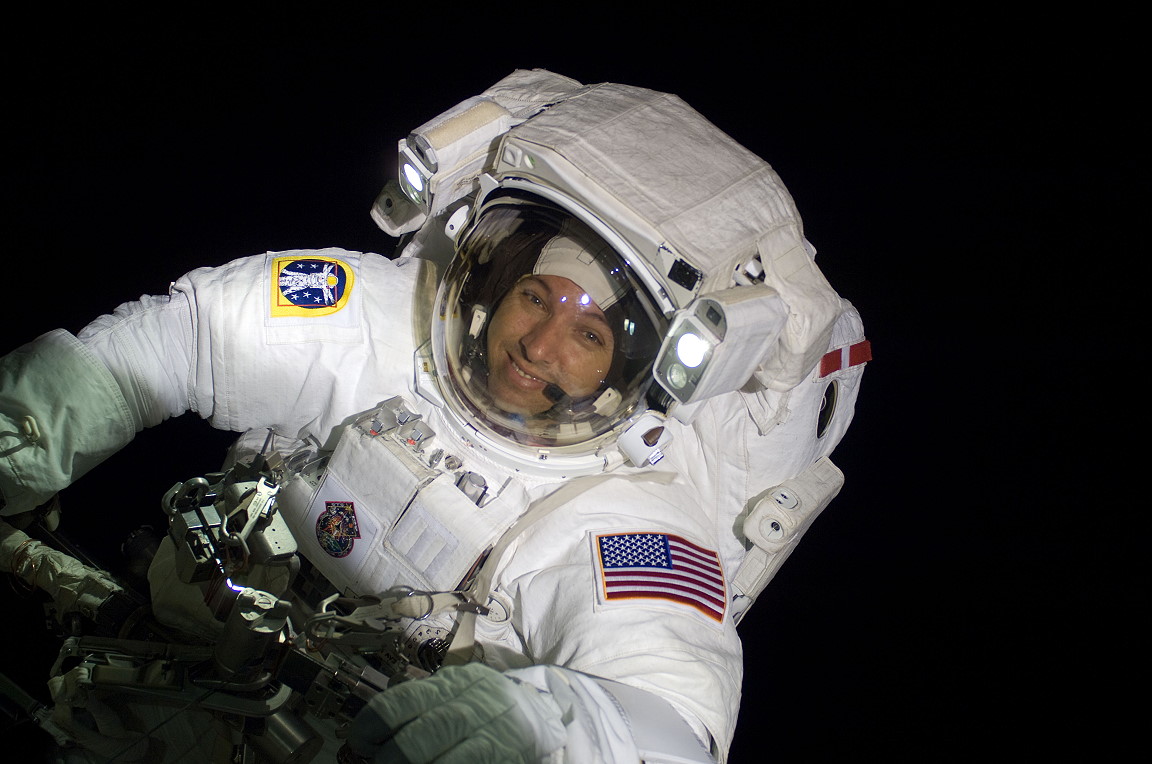
Three experienced spacefarers from three nations, with a combined total of almost a year in space, across four previous missions—to say nothing of over 31 cumulative hours of Extravehicular Activity (EVA) to their credit—gathered Wednesday at the Johnson Space Center (JSC) in Houston, Texas, to brief the media on their upcoming voyage to the International Space Station (ISS). Veteran NASA shuttle flyer Randy “Komrade” Bresnik, together with European Space Agency (ESA) astronaut Paolo Nespoli of Italy and Russia’s Sergei Ryazansky, will launch from the Baikonur Cosmodrome aboard the Soyuz MS-05 spacecraft, later this summer. During their multi-month increment, they will initially form the second half of Expedition 52, before Bresnik assumes command of Expedition 53 and celebrates his 50th birthday in orbit in September.
The crew composition was initially approved by the Multilateral Crew Operations Panel (MCOP) and formally announced by NASA in May 2016. Originally, Bresnik and Ryazansky were to be joined by Japan Aerospace Exploration Agency (JAXA) astronaut Norishige Kanai and expected to launch aboard Soyuz MS-07 in November 2017. However, as previously outlined by AmericaSpace, Russia decided last summer to reduce its crew complement from three to two cosmonauts from 2017, partly in response to significant delays which have blighted its Multipurpose Laboratory Module (MLM). As a consequence, cosmonauts Nikolai Tikhonov and Ivan Vagner were deleted from the Soyuz MS-04 and Soyuz MS-06 crew rosters. Since both men were training for the “Flight Engineer-1” position aboard the Soyuz, it became necessary to move their respective flights back by several months, in order that U.S. astronauts Mark Vande Hei and Scott Tingle could be trained and brought up to speed on this critical role.
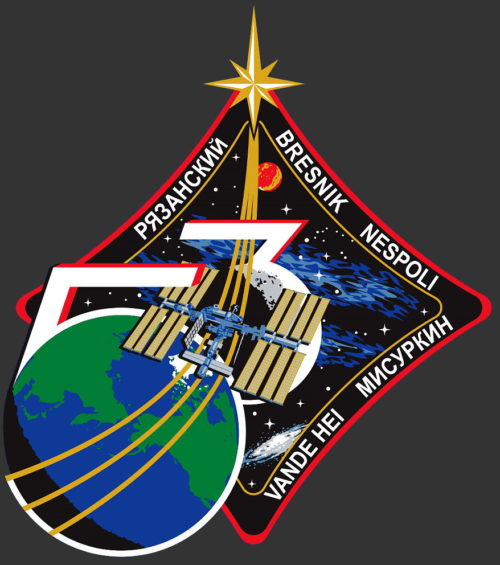
Others, including Bresnik and fellow NASA astronaut Jack Fischer, had already trained for Flight Engineer-1 duties from the outset and were more ideally placed to move forward to an earlier mission on the ISS manifest. Fischer will now launch alongside Russian cosmonaut Fyodor Yurchikhin on Soyuz MS-04 later in the spring, with Ryazansky and Bresnik advanced to the midsummer timeframe on Soyuz MS-05. Paolo Nespoli had always been scheduled to fly on Soyuz MS-05 and retained his Flight Engineer-2 seat, whilst Norishige Kanai has similarly kept his Flight Engineer-2 seat and remains anchored to Soyuz MS-07. Kanai will now accompany Russian cosmonaut Aleksandr Skvortsov and NASA astronaut Scott Tingle into orbit in November.
With 166 days from his Expedition 36/37 mission, between September 2013 and March 2014, the 42-year-old Ryazansky will lead Soyuz MS-05, seated in the center couch aboard the spacecraft for ascent and entry. Although several “civilian” Soviet and Russian cosmonauts have previously commanded spacecraft—from Nikolai Rukavishnikov in April 1979 to Oleg Kononenko on Expedition 45 in the second half of 2015—all have been engineers. Ryazansky is notable in that he is a biochemist and will thus become the first “pure scientist” to command a Soyuz. “I never dream to become a cosmonaut,” he told the audience. “I always wanted to be a scientist.” His performance was lauded by Bresnik as “seamless.” Nowhere was Ryazansky’s leadership better demonstrated than last year’s shift from a November 2017 launch with a Japanese crew member to a midsummer 2017 launch with an Italian crew member.
Both Ryazansky and Bresnik have previous EVA experience; the former having performed three spacewalks and the latter two. Current plans anticipate a single excursion from the Russian Orbital Segment (ROS), involving Bresnik and Fyodor Yurchikhin in the late summer timeframe. On the U.S. Orbital Segment (USOS), a pair of spacewalks are planned in March to support the relocation of Pressurized Mating Adapter (PMA)-3 from its current perch on the Tranquility node to its Commercial Crew location at the space-facing (or “zenith”) interface of the Harmony node. Unless those EVAs slip further downstream, Bresnik does not anticipate the opportunity to perform a spacewalk.
That said, of course, ISS operations are quite different from his previous space experience. Selected as an astronaut by NASA in May 2004, Bresnik made his first flight aboard Shuttle Atlantis on STS-129 in November 2009, performing a pair of EVAs to install and outfit external stowage platforms on the station. “It’s not shuttle,” he said of the ISS mindset, and this reality demands that crews complete skills-based training, since preparing for a specific sequence of tasks it not always possible.
This is particularly true of the visiting vehicle manifest, which includes the Russian Progress and the Japanese H-II Transfer Vehicle (HTV), as well as the cargo vessels provided by NASA’s commercial partners: SpaceX’s Dragon and Orbital ATK’s Cygnus. Current plans call for a pair of Dragons in June and September, a pair of Progresses in June and October, and a Cygnus in July. “Generically ready” was Bresnik’s description of his crew’s level of preparedness for commercial vehicles—both of which require Canadarm2 support—but he added that “all of us, being flown crew members, we’re used to thing changing.”
The exact launch date for Soyuz MS-05 remains to be seen. Provisionally, the mission is due to rise from Baikonur at the end of May, although a two-month delay until the end of July is possible. Previous Soyuz-MS missions have followed a longer-than-normal rendezvous, lasting two days, but Ryazansky hopes that theirs will revert to the shorter profile of six hours and four orbits. Nespoli has endured a two-day rendezvous, sealed inside the cramped Soyuz. “Not that comfortable,” was his summary, although for him the worst part was being strapped in for launch or entry, in a fetal position. “That’s uncomfortable!” he said, with a tone of understatement. Whenever the crew launches, they can expect to secure a couple of milestones, simply by being in space. On 11 September, for example, Bresnik will become only the second U.S. citizen, after Mike Barratt, to celebrate his 50th birthday aboard the space station, whilst Nespoli—who will have turned 60 in April 2017—becomes not only the oldest Italian ever to venture into space, but also the oldest Western European and the third-oldest human spacefarer of all time.
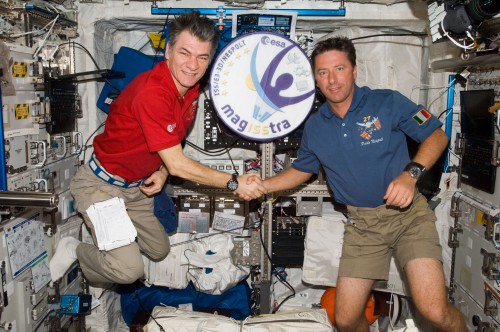
Photography will form a major focus of the crew, during their stay, with Bresnik intending to acquire imagery of locations on Earth and share via Instagram, Facebook, and Twitter, and Ryazansky and Nespoli both sharing his fascination with capturing images from low-Earth orbit. Bresnik told the audience that his grandfather had been a professional photographer and that, as a consequence, he had grown up with a camera in his hand. Yet the ability to acquire imagery of selected targets on Earth, said Nespoli, only came after several weeks in the peculiar environment of microgravity.
This will be Nespoli’s third spaceflight. He first flew aboard Shuttle Discovery on STS-120 in the fall of 2007, during which he supported the installation of the Harmony node onto the space station. He later flew a five-month increment across Expeditions 26 and 27 from December 2010 through May 2011 and his crew was visited by the final voyages of shuttles Discovery and Endeavour. The challenge of photography in space, Nespoli related, was affected very much by an awareness of the enormous velocity at which one is traveling. In the station’s multi-windowed cupola, for example, it was possible to see orbital “day” rapidly turn to “night,” to witness multiple seasons, all over the world, in rapid-fire succession, and to behold all of the oceans. When he first entered space, Nespoli found that his photographs resembled unguided snapshots, but as he grew his “space legs,” he could take a quick peek through a window and instantly know which country or continent he was over.
With over 174 days in orbit, spread across his shuttle and Expedition 26/27 missions, Nespoli is currently the most flight-experienced Italian male astronaut, surpassed only by the 199 days recorded by Samantha Cristoforetti in June 2015. Whether he launches in May or July, he will add another three to five months onto his tally, positioning himself as the second most traveled Western European astronaut, after Germany’s Thomas Reiter.
It is expected that Bresnik will rotate into the command of Expedition 53 in September 2017, becoming the first U.S. Marine Corps officer—albeit now-retired—to lead the multi-national station in its 17 years of crewed operations. Unlike Ryazansky and Nespoli, his spaceflight experience currently totals less than 11 days from his shuttle mission and his memories of the “assault on the senses” presented by seeing Earth for the first time were profound. In his remarks to the audience at today’s press conference, Bresnik remembered the “mental grasping of where you are,” which struck him immediately after the shuttle’s main engines shut down, and the realization that every human who ever lived had done so on the fragile blue ball just outside his window.
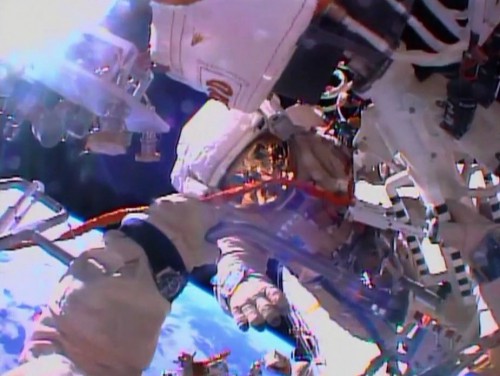
Having all traveled to the ISS before, Bresnik, Ryazansky, and Nespoli are keenly aware of its purpose as a scientific research platform and a means to develop the tools and technologies to venture beyond low-Earth orbit, eventually to Mars. In fact, “building up the knowledge that we absolutely need” before heading to the Red Planet, in Nespoli’s mind, is critical. He does not feel that the requisite level of systems redundancy and autonomous operational capability is present on today’s ISS to achieve that epic journey.
Whether the three men launch in May or July, whether they fly for five months or just three, the fact remains that time will pass quickly for them. Timepieces entered the discussion at several stages. Bresnik identified his Omega Speedmaster and noted that he was “secretly” carrying a watch for his 10-year-old son, as a future graduation gift. Nespoli, on the other hand, wore three watches during Expeditions 26 and 27: one on each wrist and another hooked to his belt. In the linear environment of the ISS, where humidity and temperature remained uniform, and time lost meaning, he needed reminding of the time in Houston, the time on-board—the station runs on Greenwich time—and the time in his homeland, Italy. From time to time, he might glance at one of his trio of watches, note that it was 1 o’clock … and have absolutely no clue if it was 1 a.m. or 1 p.m.
One of the final questions posed to Bresnik was his fighter pilot’s callsign: Komrade. With a wry grin, the ex-Marine explained that pilots often received callsigns, which were either derived from their name or from something stupid they had done. In his case, although he did nothing stupid, his surname sounded a bit like former Soviet Premier Leonid Brezhnev. And what did Russians call their comrades? Komrade quickly stuck. As his first ISS command draws closer—and with Russian, Italian, and fellow American comrades among his crew—Komrade faces his greatest adventure and greatest challenge yet.
Be sure to “Like” AmericaSpace on Facebook and follow us on Twitter: @AmericaSpace
Missions » ISS » Soyuz TMA-M »




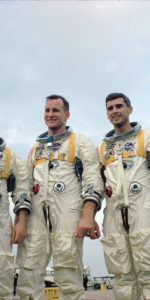
His surname sounded a bit like former Soviet General Secretary of the Central Committee Leonid Brezhnev (http://en.wikipedia.org/wiki/Leonid_Brezhnev) NOT Nikita Khrushchev!
reference: http://www.youtube.com/watch?v=Zag-n8Iw5yQ
Something I never thought of before. What if something happens on a Russian spacewalk and both cosmonauts are killed? Who pilots the Soyuz now that there are only 2 Russians aboard?
The inner ISS hatch would have to be closed manually, but other than that there is no issue. Soyuz capsules can be commanded from the ground and they are capable of fully autonomous flight, including undocking from the ISS and returning to the Earth.
Hey Randy – how can I get some of those patches? Have fun… John (Bresnik)